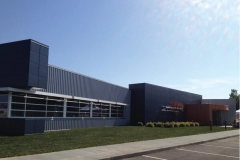Hello, I’m Rashad.
Developer of datacentercatalog.com
I’m currently open to new opportunities—remote or onsite—in the Data Center industry.
With hands-on experience in data center operations, management, and development, I’m ready to help your team succeed.
If you’re looking for someone with real-world expertise, let’s connect!
LinkedIn
Preventing System Failures with AI Predictive Maintenance
Preventing System Failures with AI Predictive Maintenance
Unexpected machine failures for manufacturers can be annoying at their least severe and extremely damaging on the other end of the spectrum. Preventing system failures can save money, time, and data, while building trust in your organization’s infrastructure.
While keeping regular maintenance schedules with prevention at the forefront can help mitigate many risks, AI predictive maintenance goes beyond this to unearth potential problems before they become disruptive. We’ll talk about how AI predictive maintenance can support business, and how it goes beyond normal preventative measures.
What is AI in Predictive Maintenance?
Artificial intelligence (AI) can be used in predictive maintenance to anticipate when adjustments to machines will be required to ensure continued operation. Instead of taking a reactive approach, predictive maintenance can use patterns and anomalies identified from historical data tracking to decide when to perform maintenance tasks.
Preventive Maintenance vs. Predictive Maintenance
Preventive and predictive maintenance have similar aims, such as minimizing downtime and maximizing performance; however, their approaches are different.
Preventive maintenance follows a set schedule for maintenance, not taking into account the actual equipment condition. While any form of regular maintenance can significantly reduce unexpected breakdowns, it can also create wasted resources by replacing machinery before it’s necessary.
Predictive maintenance takes a more methodical approach to this process, monitoring equipment health and using historical data and patterns to predict when maintenance is necessary. The approach works by using real-time data from sensors and other sources to pinpoint anticipated failures. Instead of taking a scheduled approach, predictive maintenance is a condition-based technique.
How is AI Used for Predictive Maintenance?
There are a few key processes involved in AI and predictive maintenance practices, including data management, failure protection, real-time alerts, edge computing, predictive analytics, and automation for decision-making.
Data Collection and Processing
Sensors and other devices on equipment can collect data on performance, environmental conditions, and operational parameters. After collection, data is processed to prepare it for data analysis, which involves removing noise and inconsistencies.
Machine Learning for Failure Protection
Once data has been collected and processed, it’s time to apply machine learning algorithms that can analyze the data to uncover anomalies or potential problems. This can include regression analysis, anomaly detection, and classification.
Real-Time Security Monitoring and Alerts
AI tools can also monitor data streams to find deviations and anomalies outside of the bounds of regular operating conditions. Real-time alerts allow organizations to take proactive steps toward fixing equipment.
Cloud Storage and Edge Computing
Cloud computing can serve as a component for predictive maintenance, storing the data needed to run effective predictive maintenance systems. Edge computing moves data processing and analysis closer to the equipment, reducing latency and improving response times for real-time reporting.
Predictive Analytics
Predictive analytics tools that are powered by AI offer insights for equipment, including what failures may be likely and how much useful life is likely to remain. These insights can help companies decide which maintenance tasks should be prioritized.
Automation and Decision-Making
Some parts of maintenance can also be automated by AI tools, including scheduling for repairs and creating work orders. These technologies can also help businesses make decisions about which maintenance tasks are more important.
Real-World Example in Automotive Manufacturing
Say you’re a major car manufacturer. On your production line, robotic welders are hard at work assembling critical components. But there’s a problem—weld failures aren’t being caught until final inspection. That means pulling finished vehicles off the line, redoing welds, delaying shipments, and racking up costs.
Now imagine you add AI-powered sensors to those welders. These sensors track vibration and temperature in real time. Suddenly, you’re able to detect subtle anomalies (like a slight change in vibration) that signal a weld is going off spec. The system flags it immediately, triggering maintenance before the issue snowballs.
The result? Less downtime, better quality control, and far fewer warranty claims down the line. AI turns a reactive process into a proactive one—saving time, money, and your reputation.
Why Choose an AI-Driven Approach to Predictive Maintenance?
Maintenance strategies traditionally require human intervention, and if you’ve got a team with deep experience in your equipment inventory, it can feel redundant to add an AI-driven approach to the mix, but here are some reasons organizations may want to add tools that support predictive maintenance to their workflow.
- Cost Efficiency and Savings: Predictive analytics with AI reduces maintenance costs associated with unnecessary repairs as well as unexpected downtime from failures that were not predicted. These tools also free up maintenance staff time for more critical tasks.
- Reduction in Downtime: Downtime is not only costly, it also slows delivery and can impact the trust customers have in a business. AI allows for earlier detection of anomalies, including patterns that might not be visible to the human eye until a failure is imminent. Anticipating equipment failures with AI allows for more proactive maintenance, keeping productivity high and operations running smoothly.
- Longer Equipment Lifespan: Because predictive maintenance prioritizes critical issues and allows businesses to be a step ahead of breakdowns, equipment can also enjoy longer lifespans. This improves return on investment for businesses as well.
- Improved Safety Standards: Detecting more subtle shifts in equipment performance also means that organizations can improve safety standards and reduce accident occurrences by fixing issues that may pose safety hazards.
Stay Ahead of Your Competitors by Leveraging AI
Predictive AI is changing the way organizations approach their maintenance tasks. Because AI can sort through data more quickly and effectively than humans, it can help businesses find patterns and forecast more effectively, offering an edge on the competition. The use cases for AI and machine learning (AI/ML) are growing every day. To stay ahead of the curve, it’s important to know what’s possible and what may make sense for your business.
If you’re looking to leverage the power of predictive analytics, TierPoint can provide the strategic guidance necessary to innovate and compete with others in the space. We offer IT advisory and consulting services that will allow you to unlock the potential of proactive insights—contact us to learn more.
In the meantime, download our infographic to see how AI is revolutionizing different industries across the world.

More >> Preventing System Failures with AI Predictive Maintenance


